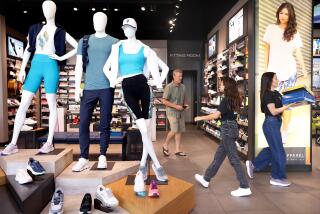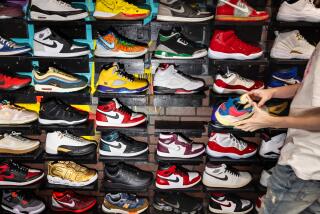Open-Toe Season : Manufacturers Scramble to Cash In on Sandal Trend
- Share via
It’s midwinter, and another layer of snow has just fallen on frigid Buffalo, N.Y.
But Ron Pecci, a Franciscan priest, is wearing sandals as he navigates the snowdrifts that ring St. Rita and St. Patrick churches. “With socks, sandals are warm enough to wear year-round,” Pecci says. “Unless it’s really cold rain, it doesn’t matter. And I wear them in the winter as long as the snow is clean.”
Consumers are rapidly discovering what the Franciscans have known for ages: Sandals can be four-season footwear, sturdy enough to go long distances over any terrain.
Some of the biggest names in footwear are scrambling to capitalize on that fact. At least 20 manufacturers are now selling sport sandals, tough footwear that travels boldly where flimsy flip-flops would never dare to go.
Footwear manufacturers are pitching sandals as appropriate gear for everything from canoeing and sailing to hiking, jogging or simply knocking about. Annual U.S. sales of sport sandals, now about $125 million, are expected to hit $400 million within a few years, industry analysts say.
The popular Birkenstock sandals, which reported 1993 sales of $60 million, are not considered sport sandals. Birkenstock maintains that its distinctive leather footwear is fine for hiking, but most manufacturers agree that the new sport sandals, with their synthetic materials, athletic designs and tougher soles, are more at home outdoors.
Sales of sport sandals started to climb three years ago after Carpinteria-based Deckers Outdoor Corp. began to market its Teva Sandals line as an alternative to traditional outdoor footwear.
Sandals strolled into the fashion spotlight just as America’s longstanding love affair with sneakers was fading. Sales of regular athletic footwear declined by 2.4% in 1992, in large part because consumers were switching to shoes that are more at home outdoors than in the gym.
“Some market changes had to occur because people were looking for something new,” says Nancy Larsen, spokeswoman for shoemaker Asics Tiger Corp. The company, based in Fountain Valley, sold 60,000 pairs of sport sandals in 1993, a 300% increase from 1992, when it entered the category.
“The outdoorsy look and the sandals craze are a natural progression as people look for something more to wear,” Larsen says.
Nike, Asics and Adidas are counting on the fast-growing outdoor market--which includes sandals--to balance the sales slowdown in their main shoe lines. But they are facing stiff competition from Timberland and other entrenched makers of outdoor footwear.
*
As manufacturers rush to meet changing consumer demands, the lines that separate footwear categories are blurring.
Asics, for example, has developed a high-performance tennis shoe that looks like a hiking boot. Shoe manufacturers are also readying “some interesting designs that mark the start of an interesting bridge between sandals and athletic shoes,” Larsen says.
As established manufacturers and upstarts jockey for position, “everyone will come out with every kind of iteration on a shoe and sandal that anyone could conceive of,” says Gary Jacobson, an analyst with the brokerage Kidder Peabody & Co. in New York. “This is just the start.”
Indeed, the nation’s leading sport sandal company is already sticking its toes into the shoe market. Deckers this fall will introduce three new Teva models that will further blur the distinction: SandalHiker, SandalShoe and SandalBoot.
“Nike, Timberland and Rockport have been in the sandal business for (at least) three years, and we’re still beating them in the marketplace,” says Peter Link, Deckers vice president. “We’re feeling pretty confident in our back yard, and now we’re going after their back yard a little bit.”
Despite strong competition, Deckers has kept its dominance of the sandals market. The company reported 1993 revenue of $50 million, up from just $5.9 million in 1990. It also made its first public stock offering last year.
Deckers’ growth is driven by sales of the Teva sandal line, which Grand Canyon river guide Mark Thatcher designed to solve a pressing personal problem: what to wear on your feet while white-water rafting. Deckers acquired the right to manufacture Teva products in 1985.
The company controls about half the sport sandal market but is keeping a wary eye on Nike. “Everybody has to pay attention to Nike because of their strength, size and power,” Deckers President Doug Otto said in a recent interview with Footwear Plus, a trade magazine.
Nike bears watching. It did not introduce its first sport sandal until late 1992 but has already logged $50 million in sales.
*
“The sandal market is booming for us,” says Keith Peters, a spokesman at the company’s Beaverton, Ore., headquarters. “Our Air Deshutz is the single largest-selling model, and we hope to overtake Teva next year.”
Several footwear manufacturers have also introduced tough waterproof sandals that do double duty as boat shoes, giving sailors gripping power combined with the comfort of sandals.
Still, fashion rather than function explains some of the sandal boom. Designers in New York and Europe are incorporating a wide array of sandals--many to be worn with socks--in their 1994 lines. College students and the coffeehouse set are also wearing sandals, even in cold climates such as Buffalo’s.
“We’re even selling them to kids who’d been wearing Doc Martens,” Watson says. “We give them a heavy look with lug soles and a nice European-looking upper.”
Gayle Rettig, who sells Birkenstocks and other sandals at stores in Dana Point and San Juan Capistrano, says sales are being driven by “a generation now in its 30s that was raised in tennis shoes . . . and who find it very difficult to put on a dress shoe that cramps their feet.”
“What’s happening to the sandal market is really amazing,” says Margot Fraser, who has marketed German-made Birkenstock footwear for 25 years.
“Things started to change two or three years ago, and sandals now have much more acceptance,” says Fraser, president of Novato, Calif.-based Birkenstock Footprint Sandals Inc., whose 1993 sandal sales of $60 million were up from $50 million in 1992.
“Particularly among men,” Fraser says. “They’re not afraid anymore to show their feet.”






